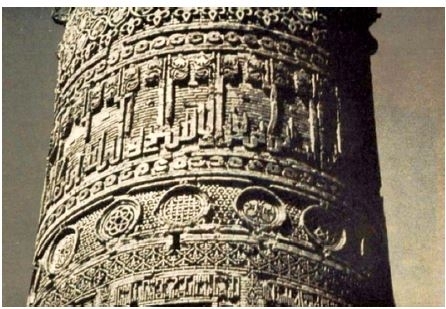The Minaret of Djam, Afghanistan
Archaeologists often ask whether spiritual, religious, political, or economic movements are reflected in the structure and decorations of monuments. Focusing on this basic question, this chapter attempts to shed light on the historical and cultural movements reflected in the Minaret of Djam, that unique relic of the Ghurid dynasty (1148–1215 CE). Described in detail by several scholars, this monument has often been characterised as a ‘tower of glory’ commemorating a victory under the Ghurid overlord, Ghiyath al-Din Muhammad b. Sam (d. 1203), over the Ghuzz nomads at Ghazna in 1173, or perhaps the elevation of his brother Mu‘izz al-Din Muhammad b. Sam (d. 1206) to the sultanate (r. 1203–06), rather than later victories on the northern Indian sub-continent.
The World Heritage listed11 Minaret of Jåm (Figure) has some of the most extensive Qur’anic inscriptions on any monument ever raised. According to the archaeologist David C. Thomas, ‘the date of the construction of the minaret is less clearly preserved’ in the brickwork of the foundation panel. The Arabic words for seventy (sab’in) and ninety (tis’in) are ‘virtually indistinguishable in the absence of diacritics’. Thomas tells us that Sourdel-Thomine dated the tower to 570 AH (2 August 1174 to 21 July 1175 CE), disagreeing with Pinder-Wilson, who prefers Maricq and Wiet’s reading of 1193/94.13 The tower, the second tallest (64.6m)14 brick minaret after the Qutb Minar, has an octagonal base diameter of 9.14m, and stands on the south bank of the Heri Rud in a remote narrow valley amidst the impressive Central Mountains geographical region in Ghur, Shahrak District (Figure 2).
This hypostyle mosque was founded in 641–2 by the Muslim conqueror of Egypt and was rebuilt and enlarged in 673 during the reign of Mu‘awiyah ibn Abi Sufyan (602–80), the first Umayyad caliph, who added a minaret to each of its four corners.24 Creswell believed that these early minarets were called sawma‘a as they were likened to the small square cells used by the Christian monks of Syria. Later, the square minarets followed Umayyad expansion into North Africa and Spain. Throughout medieval times, the minaret was regarded as the majestic tower ‘in its lofty height and magnificent formation’. During this period, as they came into contact with other tower traditions, Muslims developed various regional minaret types.



